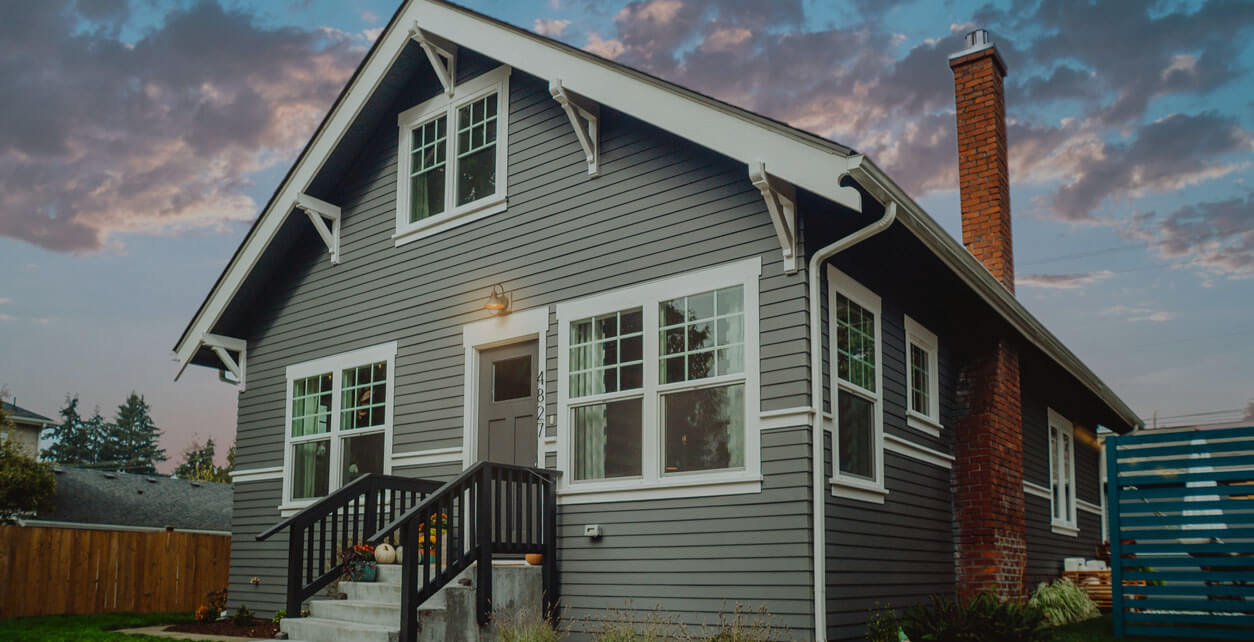
Below, I’ve put together a list of the most common and most important. A home inspector would likely pick up on all of these, but it’s useful for prospective buyers to know them as well, so you can avoid non-starters before you get to the inspection stage.
1) Little Black Dots
Mold is a serious issue in aging homes, especially in damp climates like the Pacific Northwest. It can cause health problems; removal can be expensive; and it can signal bigger issues related to moisture in the home. There are a few telltale indicators of a mold problem, but the most common are black or grey spots. These generally show up on bathroom walls, shower ceilings, under sinks and around pipes and drains. Make sure you check these areas if you’re considering a purchase.
2) Wonky Walls and Tiny Stairs
Some homeowners are skilled builders who take care to conform to code when they take on DIY renovations – but some aren’t, and the result can be painful for the next owner. When touring a home, keep an eye out for anything in the structure that looks a little off – oddly placed outlets, narrow or shallow stairs, low railings, disjointed walls. These wonky features could well point to DIY renos that were completed without a permit or the proper expertise. If that’s the case, it could mean a costly redo down the road.
3) Telltale Droplets
Water on the outside of a window is fine. Water on the inside is a different matter. Droplets and water vapour should never appear on interior of a window or inside a double-glazed pane. If you see this, chances are a seal has failed and the window (or windows) need replacing. That can mean a big bill.
4) Roses and Cinnamon
It’s not uncommon for home sellers to use a bowl of flowers or some freshly baked cookies make a space feel inviting. But if the seller has had to work to create that effect – if there are deodorizers throughout the house, scented candles burning in the living room or even an open window on a cold day – it should be cause for concern. Strong fragrances or unusual air flow may well be masking something bad, like smoke or pet odours – or something worse, like the smell of mold or mildew. If it smells suspiciously good, be sure to find out why.
5) Sticky Doors or Windows
Doors and windows should be easy to open. If they’re not – if they stick when you push or pull them – it could be an indicator of a bigger problem, like a bad renovation or a subsiding foundation that has thrown the home out of alignment. This type of issue will likely need fixing down the road, and that could mean a big unwanted expense. If you notice sticky doors or windows – or worse, a sloping floor – ask your real estate agent to take a closer look.
6) Fresh Paint in Odd Places
There’s nothing wrong with a newly painted home. In fact, I often advise clients to add a fresh coat of paint to boost their home’s value. But when new paint appears in an isolated spot – a single wall, a portion of a ceiling, a foundation wall – it can be a bad sign. Sometimes, an unscrupulous seller will use this tactic to hide an ongoing problem, such as water penetration, which will make for a headache for the buyer down the line. If you notice this type of unusual paint job, be sure to make inquiries.
7) Pools on the Lawn
If managed poorly, water can cause endless problems for home owners. So before you invest in a property, make sure it’s draining as it should. That means keeping an eye out for telltale signs – big puddles on the lawn or migrating mulch in flower beds – that suggest water is hanging around longer than it should. If you notice these things, proceed with caution. Fixing a drainage issue can be a costly endeavour.
8) Cracks in the Walls
Tiny cracks aren’t unusual in a home’s foundation – and can likely be disregarded – but big cracks are something else entirely. If you’re touring a home and you notice substantial fissures in concrete foundation walls – or cracks of any kind above windows – it could mean the structure is subsiding. Be sure you get the house inspected – and consider avoiding the purchase entirely.
9) A Ring in the Basement
Water in the past can be just as bad as water in the present. When touring a basement or laundry room, take a close look at the walls – including the hard-to-see areas under the stairs and behind water heaters. Discolouration near the bottom of a foundation wall, rust at the bottom of basement shelving or water stains around pipes could be a result of past flooding and lingering water damage – something that’s better avoided.
10) Peeling Paint
Walls and ceilings should look seamless. If you notice peeling or bubbling paint around doors, windows or vents, it could indicate poor ventilation, poor upkeep or a low-budget renovation. Be sure you understand why it’s happening, and account for the cost of repairs when making your homebuying decision.
11) Whale Song on Full Blast
A homeowner who puts on music during an open house may simply be trying to create ambiance, but they may also be trying to mask a problem, such as loud traffic or other persistent noises. When you notice prominent music on a tour, open a window or step out onto a deck to check for yourself.
12) Tall Hedges
Big barriers are usually there for a reason. If a home is surrounded by tall hedges, find out why: Is there a lot of traffic on a road nearby road? Is the hedge blocking bad neighbours? Be sure you know the answer before making a purchase.
13) Broken Switches and Dirty Dishes
Generally speaking, open houses are meticulously clean, newly repaired and often professionally staged. If a homeowner hasn’t done these things – if they haven’t tidied or performed routine repairs – it may indicate a lax approach to upkeep. If they haven’t done the dishes or repaired the porch light, have they been neglecting bigger issues? If an open house strikes you as poorly staged, pay close attention.
14) A Long Wait for the Elevator
In any big residential building, the elevator should come promptly. If you find yourself waiting for an unusually long time, it might be cause for a concern. The delay could mean one of the elevators is out of commission and in need of repairs – an expense that will fall on strata owners – or it could mean an inadequate piece of hardware that will be a perpetual source of inconvenience. Either way, it should count as a mark against a potential purchase.
15) Big Trees
A big, beautiful tree on the property is not always a good thing. Sometimes, its roots will extend to the house, where they have the potential to damage to the foundation. If there’s a big tree near the home, make sure you get your inspector to check it out before you commit.
16) Too Many For-Sale Signs
Sometimes multiple homes on a single street will come on the market all at once. Often there’s a reason for this, and that reason may or may not be good. If you notice an unusual number of for-sale signs near an open house – or posters advertising a redevelopment – it’s time to do some homework. Ask a neighbour, check the city’s website or talk to your real estate agent to be sure you understand what’s going on. When you find your answer, ask yourself if it’s something you can live with before you put in an offer.
